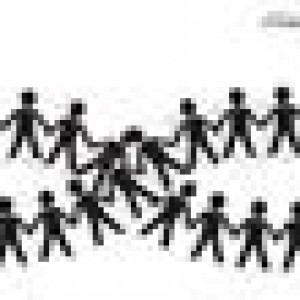Palestinian Central Bureau of Statistics (PCBS) and National Population Committee On the Eve of the International Population Day 11/7/2016

The Estimated Population of Palestine at mid 2016 was about 4.81 Million
The total population of Palestine at mid 2016 was about 4.81 million; 2.45 million males and 2.36 million females. The estimated population of West Bank was 2.93 million of which 1.49 million males and 1.44 million females. While the estimated population of Gaza Strip totaled 1.88 million of which 956 thousand males and 925 thousand females. The percentage of urban population at mid 2016 was 73.9%, while the percentages of population in rural and camps areas were 16.6% and 9.5% respectively.
Palestinian Population in Gaza Strip is Younger than the West Bank Population
The percentage of individuals aged (0-14) constituted 39.2% of the total population at mid 2016 of which 36.9% in the West Bank and 42.8% in Gaza Strip. The elderly population aged (65 years and over) constituted 2.9% of the total population of which 3.2% in the West Bank and 2.4% in Gaza Strip at mid 2016.
High Population Density in Gaza Strip
Population density of Palestine is generally high at 800 persons/km2, particularly in Gaza Strip it is 5,154 persons/km2 compared to a lower population density in the West Bank of 519 persons/km2 at mid 2016.
High Fertility Rates in Gaza Strip compared to the West Bank
According to results of Multiple Indicator Cluster Survey 2014, the total fertility rate in Palestine had declined to 4.1births (2011-2013) compared to 6.0 births in 1997. At the regional level, the fertility rate in Gaza Strip is higher than West Bank during the period between (1997-2013), where it reached 3.7 births during the period between (2011-2013) in the West Bank compared to 5.6 births in 1997. While it reached 4.5 births in Gaza Strip during the period between (2011-2013) compared to 6.9 births in 1997.
Decline in Crude Birth and Death Rates During (2016-2020)
Population projections revealed that crude birth rate in Palestine is expected to drop from 30.9 births per 1000 of the population in 2016 to 29.0 births per 1000 in 2020. On the other hand, the crude death rate is expected to decline from 3.5 deaths per 1000 of the population in 2016 to 3.4 deaths per 1000 in 2020 in Palestine.
Decline in the Average Household Size
Data revealed a decline in the average of households size in Palestine during the period between (1997-2015) from 6.4 persons in 1997 to 5.2 in 2015. This average declined in the West Bank from 6.1 persons in 1997 to 4.9 in 2015, while it declined in Gaza Strip from 6.9 persons to 5.7 for the same period.
One Household out of ten Households is Headed by a Female
Data of 2015 showed that 10.9% of households were headed by females in Palestine as of 12.2% and 8.6% in the West Bank and Gaza Strip respectively. The size of female-headed households were relatively small, with an average size of 2.9 persons compared to 5.7 persons for male-headed households.
Females Participation Rate in Labour Force is very Low Compared to Males in 1st Quarter of 2016
The results of labour force survey revealed that the labour force participation rate in the 1st quarter of 2016 is 45.8% of the total labour force (Persons aged 15 years and above) of which 45.5% in the West Bank and 46.4% in Gaza strip. The females participation rate in labour force is very low compared to males participation rate in the 1st quarter of 2016 is 19.4% of which 17.7% in the West Bank and 22.3% in Gaza Strip, against 71.6% for males; of which 72.6% in the West Bank and 69.9% in Gaza Strip.
About One Fourth of Participants in the Labour Force were Unemployed in 1st Quarter of 2016
The results showed that more than one fourth of participants in the labour force were unemployed in the 1st quarter of 2016 at 26.6% as of 18.0% in the West Bank and 41.2% in Gaza Strip. Unemployment rate reached 42.8% among females compared to 22.3% among males.
9.2% of Individuals (15 years and above) didn't Complete any Stage of Education
The 2015 data revealed that the percentage of individuals (aged 15 years and above), who have completed university education (A bachelor degree and above), was 13.0% while the percentage of individuals who didn't complete any stage of education reached 9.2%.
Female Illiteracy Rate was three and half Times Higher than that of Males
Illiteracy rate among individuals aged 15 years and over in Palestine was 3.3% in 2015. Illiteracy gap is significantly noticed among males and females at 1.5% and 5.1% respectively.
More than Three-Quarters of Housing Units in Palestine Owned by a Family Member
In 2015, the percentage of Palestinian households that a family member owned a housing unit was about 80.9% of which 81.9% in the West Bank and 79.0% in Gaza Strip, while the percentage of households who were living in rented houses in Palestine was 7.8% of which 8.9% in the West Bank and 5.7% in Gaza Strip.
93.3% of Palestinian Households Connected to Water Public Network as Main Source
Available data for 2015 showed that 93.3% of households in Palestine lived in houses that are supplied with drinking water from public network of which 93.4% in the West Bank and 93.0% in Gaza Strip. Moreover, almost all of households in Palestine lived in houses connected to the electricity network.
More Than Half of Palestinian Families Living in Houses Connected to Public Sewerage Network
Data of 2015 showed that About 45.3% of Palestinian households were living in houses connected to tight\ porous cesspits, of which 60.4% in the West Bank and 16.5% in Gaza Strip. While there were 53.9% of Palestinian households were living in houses connected to public sewage network of which 38.4% in the West Bank compared with 83.5% in Gaza Strip.
For the full report, please click here: http://www.pcbs.gov.ps/site/512/default.aspx?tabID=512&lang=en&ItemID=1701&mid=3171&wversion=Staging